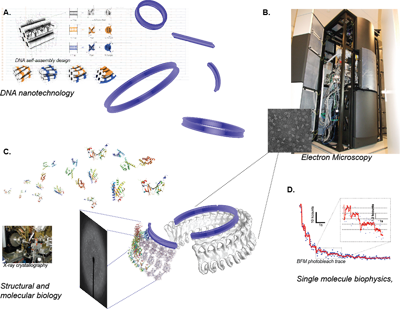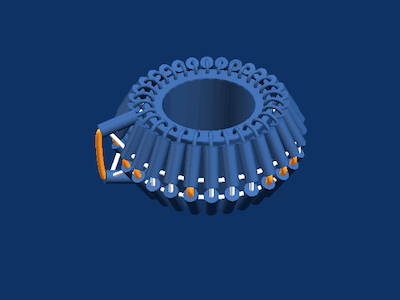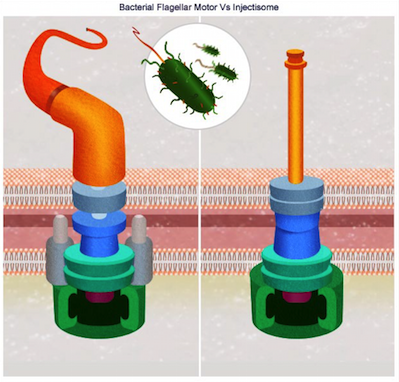
Lawrence Lee
Dr Lawrence Lee is an ARC Discovery Early Career Research Award Fellow at the University of New South Wales and an Honorary Faculty Member at the Victor Chang Cardiac Research Institute. He received his PhD from the University of Sydney in 2008 before undertaking postdoctoral studies at the VCCRI where he started his independent research group in 2011. He was awarded the Young Investigator of the Year award from the National Association of Research Fellows (2010), a European Molecular Biology Organisation Fellowship at the University of Oxford (2012) and a NSW Young Tall Poppy Award in 2014.
Single Molecule Science C25, Level 3 Lowy Cancer Research Centre
- Publications
- Career highlights
- Research projects
- Teaching & supervison
- Collaborators
- In the media
Select Publications
Berengut JF, Wong CK, Berengut JC, Doye JPK, Ouldridge TE, Lee LK. Self-Limiting Polymerization of DNA Origami Subunits with Strain Accumulation. ACS Nano (2020) 14 (12), 17428-17441
Jonathan F Berengut, Julian C Berengut, Jonathan P K Doye, Domen Prešern, Akihiro Kawamoto, Juanfang Ruan, Madeleine J Wainwright, Lawrence K Lee. Design and synthesis of pleated DNA origami nanotubes with adjustable diameters. Nucleic Acids Research (2019) 47 (22), 11963–11975
MAB Baker, DJ Nieves, G Hilzenrat, JF Berengut, K Gaus, LK Lee. Stoichiometric quantification of spatially dense assemblies with qPAINT. Nanoscale (2019) 11 (26), 12460-12464.
Baker MAB, Tuckwell AJ, Berengut JF, Bath J, Benn F, Duff AP, Whitten AE, Dunn KE, Hynson RE, Turberfield AJ, Lee LK. Dimensions and global twist of single-layer DNA origami measured by Small-Angle X-ray Scattering. ACS Nano 12(6): 5791–5799 doi: 10.1021/acsnano.8b01669 (2018)
Rosholm KR, Baker MAB, Ridone P, Nakayama Y, Rohde PR, Cuello LG, Lee LK#, Martinac B. AP#. Activation of the mechanosensitive ion channel MscL by mechanical stimulation of supported Droplet Hydrogel bilayers. Scientific Reports 7:45180 doi: 10.1038/srep45180 (2017)
Baker MAB, Hynson RMG, Ganuelas LA, Shah Mohammadi N, Liew CW, Rey AA, Duff AP, Whitten AE, Jeffries CM, Delalez NJ, Morimoto YV, Stock D, Armitage JP, Turberfield AJ, Namba K, Berry RM, Lee LK. Domain-swap polymerization drives the self-assembly of the bacterial flagellar motor. Nat Struct Mol Biol 23(3):197-203 doi: 10.1038/nsmb.3172. (2016)
Al-Zyoud WA*, Hynson RMG*, Ganuelas LA, Coster ACF, Duff AP, Baker MAB, Stewart AG, Giannoulatou E, Ho JWK, Gaus K, Liu D, Lee LK#, Böcking T#. Binding of transcription factor GabR to DNA requires recognition of DNA shape at a location distinct from its cognate binding site. Nucleic Acids Research, 18;44(3):1411-20 doi: 10.1093/nar/gkv1466 (2016)
Kwon, Y.D., et al. Crystal structure, conformational fixation and entry-related interactions of mature ligand-free HIV-1 Env. Nat Struct Mol Biol 22(7), 522–531 (2015). doi:10.1038/nsmb.3051
Lee, L. K., Ginsburg, M., Crovace, C., Donohoe, M., Stock, D. The structure of the torque ring of the flagellar motor and the molecular basis for rotational switching Nature 466(7309): 996-1000, (2010)
Lee, L. K., Stewart, A.G., Donohoe, M., Bernal, R.A., Stock,D. The structure of the peripheral stalk of Thermus thermophilus H+-ATPase/synthase Nat Struct Mol Biol 17(3): 373-378, (2010).
* these authors contributed equally # joint corresponding authors
Career highlights
- NSW Tall Poppy Award (2015)
- ARC Discovery Early Career Research Award (2014)
- EMBO Fellowship, Oxford University, UK (2012)
- National Association of Research Fellows, Young Investigator of the year (2010)
Artificial synthesis of complex nanoscale biological machines
At the time of his death, Richard Feynman left an insightful comment on his blackboard: "What I cannot create, I do not understand". Here Feynman sets a challenging benchmark for scientific discovery, especially in biological systems whose properties depend on the interplay of many components. The reality is that although our understanding of biology has continued to grow exponentially since Feynmann’s death, his approach was simply not possible in biology. Instead, biologists adopt a ‘top-down’ approach; we let nature build things such as ecosystems, organisms, cells or large protein complexes, then we try to understand them. This provides assurance that we are studying correctly assembled systems, but restricts our ability to simplify or manipulate them to understand their various components. 30 years later, are things about to change?
We study complex and supramolecular biological machines by artificially constructing them form the bottom up. Two machines that we currently work on are the bacterial flagellar motor, a molecular motor that can rotate at over 100,000 rpm and ultrasensistive sensor that allows it to switch directions in milliseconds or the type III secretion system, bacteria’s molecular syringe that injects virulence factors directly into host cells. To build these machines we design and synthesise custom nanoscale structures made from DNA that we use to template the assembly of engineered protein components. This fundamentally new approach to biology allows us to explore fascinating questions about the molecular world, which are at the heart of how life exists. For example, how do many thousands of ‘brainless’ molecules self-organise into sophisticated functional machinery? Or once assembled, how do these ‘brainless’ molecules somehow talk with each other to coordinate their activities?

Bioinspired technologies
After 60 years of miniaturisation, man made devices have reached the scale of biological protein machines. But compared to nature’s machines, nanoscale man-made devices are rather crude and basic. After all, biology has had a 4 billion year head start. Hence, the concept of synthesising biological machines naturally takes the imagination to bio-nano hybrid technologies, which are so often the subject of science fiction. We are also exploring the possibility of turning fiction into reality by harnessing synthetic nanomachines for technological advance. One example shown below is a cooperative DNA origami structure where the same principles that drive the ultrasensitive switch in the bacterial flagellar motor are being applied to construct a biosensor for viral pathogens.

Structure and activity of membrane proteins with simultaneous single molecule fluorescence and electrophysiologal measurements
Integral membrane proteins, such as ion channels and G-protein coupled receptors are important players in cellular signalling processes and constitute some of the most important protein targets for drug delivery. However, their hydrophobic surfaces, flexibility and lack of stability outside their native membrane environment, present technical challenges for investigating their structure and activity by conventional methods (e.g. NMR and X-ray crystallography). To overcome this challenge we are currently establishing a setup (developed in Oxford) for investigating membrane proteins within their natural membrane surroundings. The setup consists of a supported lipid membrane formed between a hydrogel surface and a water droplet and is designed to facilitate parallel current and fluorescence measurements of single reconstituted membrane proteins. We envision this multidisciplinary strategy will provide unprecedented insights into the molecular mechanism governing the activation and function of integral membrane proteins, which will be imperative for the development of novel drug-design strategies.

Adapting Bacterial Motility in the Laboratory using Experimental Evolution
The bacterial flagellar motor is one of the pinnacles of evolution, and one of the oldest sources of motility in existence. We use biophysics, microbiology and genetic engineering techniques to examine exactly which small changes result in the emergence of the complex outboard motor that powers the ‘salmonella speedboat’. We apply selection pressure to evolve changes in the motor, such as changing its energy source, and then characterize the genetic and phenotypic changes the motor undergoes throughout this process. This project involves microscopy, single molecule fluorescence, microbiology and bacterial genetics, and provides a platform for work at the interdisciplinary intersection of physics, evolutionary biology, and biochemistry, to explore the complex origins of nature’s fastest rotary motor.

Lab Members
- James Brown (Postdoctoral fellow)
- Stephanie Xu (PhD student)
- Min Huang (PhD student)
- Brian Ee (PhD student)
- Tyson Capewell (Honours)
- Ismat Kabbara (Intern)
Past Lab Members
- Matt Baker (Postdoctoral fellow)
- Chu Wai Liew (Postdoctoral fellow)
- Kadla Rosholm (Postdoctoral fellow, Carlsberg and VCCRI Prince Christian Fellow)
- Austin Boucinha (Intern student, University of Waterloo, Canada)
Completed Students (PhD)
- Andrew Tuckwell
- Sophie Hertel
- Jon Berengut
- Rokiah Alford
Completed Students (Masters)
- Lorraine Ganuelas
Completed Students (Honours)
- Gonzalo Peralta
- Abi Prakash
- Boaz Ng
- Wunna Kyaw
- Maddie Wainwright
- Alex Mars
- Linda Chen
- Hugh Russell
International
- Prof Keiichi Namba, Osaka University Japan
- Prof Andrew Turberfield, Oxford University, UK
- Dr Richard Berry, Oxford University, UK
- Prof Judith Armitage, Oxford University, UK
- Prof Michio Homma, Nagoya University, Japan
- Dr Peter Kwong, Vaccine Research Centre, NIH, USA
- Dr Cy Jeffries, EMBL Hamburg, Germany
Australian
- Dr Till Böcking, University of New South Wales, Sydney
- A/Prof Adam Micolich, University of New South Wales, Sydney
- Dr Anthony Duff, Australian Nuclear Science and Technology Organisation, Sydney
- Prof. Boris Martinac, The Victor Chang Cardiac Research Institute
Current funding sources
- Australian Research Council (Discovery Projects, Discovery Early Career Research Award)
- Human Frontiers Science Program (Project Grant)
- Ramaciotti Foundation (Establishment Grant)
- National Health and Medical Research (Project Grant)
